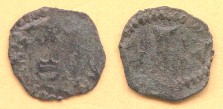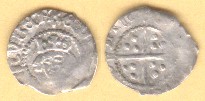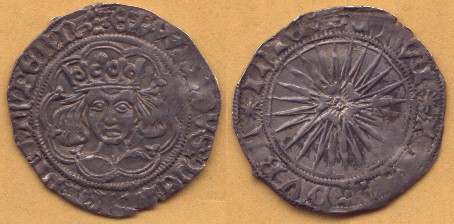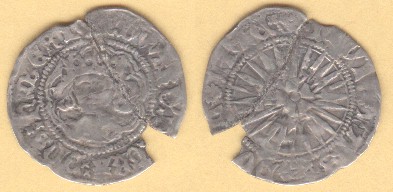Irish Coinage
____________________
Edward IV
Part I
Irish Coinage of Edward IV Part I (1460 to 1470)
Index
©
2002 - Copyright
John_Stafford-Langan
Version 1.09a
7 January, 2002
Introduction to the Irish Coinage of Edward IV
As can be seen by the preceding sections the Irish economy had been subject to significant export of silver as a result of the English crown striking Irish silver into coins which could circulate freely in England. In 1459 in return for support for his campaign to gain the English crown Richard Duke of York granted the Irish authorities permission to strike coins to a lower 'Irish standard' and to introduce a base metal coinage.
The economic benefits were clear - the overseas landowners were more likley to invest their rental income in Ireland and generate local economic activity if the money could only be exported at below par.
Richard won the crown but lost his life! (Hence : Richard Of York Gave Battle In Vain) so his eldest son Edward became Edward IV in 1460.
The following 23 years until Edward's death in 1483 were witness to a continual struggle between the local Irish authorities striving to maintain a lower Irish standard, the King trying to exercise control over coinage struck in his name which sometime circulated in England (to the great annoyance of the English merchant class because of the lower standard) and the unscrupulous activities of a series of Irish mintmasters.
For numismatists this
struggle led to a wonderful series of coins being
produced with a variety of designs, mints, and standards
which are still today being untangled. My forthcoming
paper on this reign will move the confusion to a higher
level!
In short there are six distinct designs. Two of which
have more than one weight standard. There are factions
between Eastern and Southern mints. There are base metal
and billon issues and there are lots of mints (some of
which were illegal, and some of which are still
unrepresented by a surviving coin).
This page is quite long and is divided into sections corresponding to the main issues of the period. To jump directly to a point on this page select one of the topics below.
- First 'Anonymous' Issue (1460-1462)
- Titled Crown Issue (1463-64)
- Heavy portrait Isssue (1465-66)
- 'Doubles' Issue (1467)
First 'Anonymous' Issue (1460-1462)
In 1459 the 'Irish' standard was set to 45 grains of silver to the groat - which was 3/4 of the then English standard of 60 grains of good silver to the English groat. So an Irish groat carried to England would be worth only three English pence - with the distinctive design this was clearly an incentive to keep Irish silver in Ireland, which was exactly the result that Irish nobility wanted.
The first coins issued under this authority were anonymous silver groats and pennies and half farthings in copper.

An Early 'Anonymous' Groat of Edward
IV - 1460
This groat was the first issue of a groat in Ireland, the previous coinage being limited to pennies, halfpennies and farthings. The lack of an obverse legend gave the engravers a larger than normal workspace and the resulting coin features a very finely executed crown. The penny is identical in design but smaller (and 1/4 the weight). The coins are signed from Dublin, with one exception of a fragmentary penny which clearly has a W (Waterford) at the begining of the mint signature.

Edward IV - Copper Half Farthing - 1461
The copper half farthing was an further departure from 'English' practice as there had been no base metal coinage issued in the English series for many generations (since the Middle Anglo Saxon stycas of circa 850 AD). The copper coins are usualy difficult to decypher and just carry the single legend PATRICUS.
Titled Crown Issue (1463-64)
In 1463 Edward appointed Germyn Lynch as mintmaster in Ireland and authorised a new coinage. The new coinage was described in some detail in the coinage act of 1463. Most significantly the coins carry Edward's name and the reverse design reverts to the normal 'English' type. However the coinage is distinctly Irish in several respects; the crown design is retained instead of reverting to the 'English' style of protrait and the standard is still retained at a margin below the English standard for the groat.
Edward IV Titled Crown Groat, 1463 - Waterford
The English standard groat was lowered to 48 grains in 1464 - which given that the Irish groats should weigh 45 grains seems to dissipate much of the weight distinction and therefore to allow for easier export of Irish coins. However most of the Irish coins of this period appear to have been struck to a standard of about 41 grains.
The explanation for the different weight standards appears to be that Germyn Lynch was wise to an opportunity and he appears to have found favour amongst the Irish nobility for redefining the Irish coinage in terms of the Tower Ounce of 450 grains instead of the Troy ounce of 480 grains. This gave the local nobility some further differentiation in weight vis-a-vis the English currency and presumably gave Germyn Lynch a tidy profit on his activities.
Heavy portrait Isssue (1465-66)
In 1465 Edward again changed the design of the Irish coinage and authorised the striking of coins of a purely English type. As the weight difference was retained this was an economically disasterous move for Ireland and the local nobility.
The production of official Irish coins which were very difficult to distinguish from English ones, but which were struck at 41 grains to the groat instead of the English standard of 48 grains, meant that Irish coins began to circulate at par in England despite their low weight. This gave rise to many English merchant's petitions to the English king asking him to either restore the weight standard or make the light Irish coins more distinctive.
Hoverer the consequences in Ireland were more severe - the latent pressure on money to move out of Ireland to England hade been held back by the differences in coinage introduced in 1460, but these new coins issued in 1465 were ideal for export. So much so that there is suspicion that Lynch was in the business of producuing these coins for export.
The net effect was a very quick drain of silver from Ireland and a period of significant economic hardship began in 1466/7.

Edward IV Heavy Portrait Groat - Dublin

Edward IV - Heavy Issue Halfgroat - Dublin

Edward IV Heavy Portrait Penny - Dublin

Edward IV - Heavy Issue - Halfpenny - Dublin
'Doubles' Issue (1467)
In 1467 Edward appointed Sir John Tiptoft as his justiciar in Ireland. One of Toptoft's early actions was a co0mplete overhaul of the coinage.
He modified the design to an Irish type - in this case retaining the portrait thet Edward had eventually restored two years earlier, but he introduced a significantly modified and specifically Irish type reverse. This features a full blown rose superimposed on large sun of 24 rays.
He drastically revalued the coinage so that an Irish groat was only 22 1/2 grains (compared with 41 grains in the 1465 issue). However he introduce a 'groat sized' coin which he valued at 8 pence an called a double grout and which weighed 45 grains. These double groats are again very spectacular coins because of the single legend on the reverse and the larger area for the 'Irish' rose on sun design.
He made the use of all previous coin issued illegal. This single step which required peopel to turn in their old con for reminting into new coin ensured that the struggling economy would grind to a complete halt. As much of the remaining silver coin that was of an acceptable standard was exported as exchanging it would result in effectively givving 40% or so of the silver weight to the mint.

Edward IV - Double Groat - 1467 - Dublin

Edward IV Doubles Issue Groat - Dublin
This coinage is, unsurprisingly, rare - and its introduction explains why the previous Irish style coinages of Edward are also rare and why so many of the surviving examples were found in England rather than in Ireland. The exception is the 1465 issue which while scarce is not nearly as rare - the explanation appears to be simply that these coins were so similar to the 'English' local currency that they were less easy to identify readily and remained circulating and being horarded etc along with the normal English coins whereas the distinctive Irish types were less attactive to hoarders and quickly fond their way to the melting pot.
In 1470 Edward briefly lost the throne to Henry VI (who preceeded him in 1460). Henry died several months later and Edward IVregained the throne in 1471.
There are no Irish coins currently attributable to Henry VI - there is a penny with a rose reverse which is currently attributed to Henry VII (and is most likley a very early 1485 issue) - but which could be attributed to this 1470-1471 period.
| Continue to : |
|